
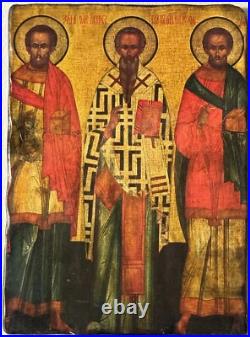
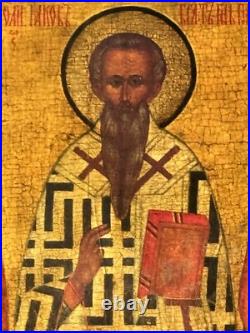
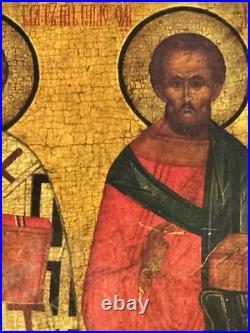
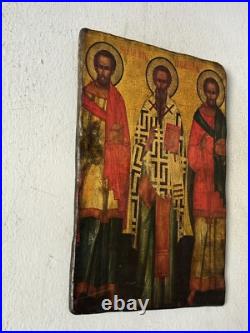
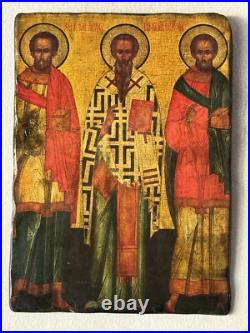
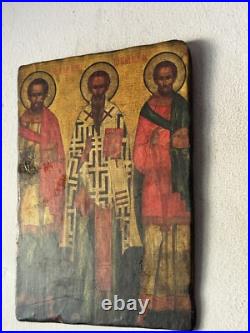
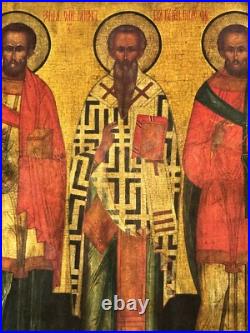
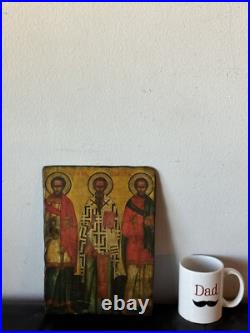
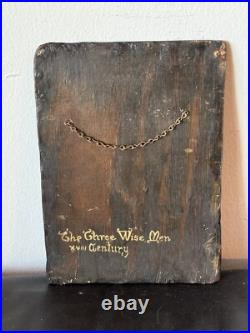

HISTORICAL ANTIQUE HOLY CHRISTIAN IMPRESSIONIST PRINT ON BOARD DEPICTING THE ICONIC THREE WISE MEN, AKA THE THREE HIERARCHS. THIS WORK CELEBRATES SAINTS IN CHRISTIAN THEOLOGY, REVERED FOR THEIR WISDOM AND CONTRIBUTIONS TO THE FAITH. THIS WORK WOULD SERVE AS A REMARKABLE CENTERPIECE IN ANY COLLECTION, OFFERING A CONNECTION TO THE ARTISTIC AND RELIGIOUS TRADITION OF JESUS CHRIST. IT APPEARS TO BE UNSIGNED. MILD CRAQULURE FROM OLD AGE. DIMENSIONS: 12″ H x 9″ W. In Christianity, the Biblical Magi, also known as the Three Wise Men, Three Kings, and Three Magi, are distinguished foreigners who visit Jesus after his birth, bearing gifts of gold, frankincense, and myrrh in homage to him. They are commemorated on the feast day of Epiphany-sometimes called “Three Kings Day”-and commonly appear in the nativity celebrations of Christmas. The Magi appear solely in the Gospel of Matthew, which states that they came “from the east” to worship the one who has been born king of the Jews. Their names, origins, appearances, and exact numbers are unmentioned and derive from the inferences or traditions of later Christians. In Western Christianity, they are usually assumed to have been three in number, corresponding with each gift; in Eastern Christianity, especially the Syriac churches, they often numbered twelve. Likewise, the Magi’s social status is never stated: Although some biblical translations describe them as astrologers, they were increasingly identified as kings by at least the third century, which conformed with Christian interpretations of Old Testament prophecies that kings would worship the messiah. Both secular and Christian observers have noted that the Magi popularly express various ideas, symbols, and themes. Most scholars regard the Magi as legendary rather than historical figures. Traditional nativity scenes depict three “wise men” visiting the infant Jesus on the night of his birth in a manger accompanied by the shepherds and angels, but this should be understood as an artistic convention allowing the two separate scenes of the Adoration of the Shepherds on the birth night and the later Adoration of the Magi to be combined for convenience. The single biblical account in Matthew 2 presents an event at an unspecified point after Jesus’s birth in which an unnumbered party of unnamed “wise men” (????? , mágoi) visits him in a house (?????? , oikian), not a stable. The New Revised Standard Version of Matthew 2:1-12 describes the visit of the Magi in this manner. In the time of King Herod, after Jesus was born in Bethlehem of Judea, wise men from the East came to Jerusalem, asking, Where is the child who has been born king of the Jews? We observed his star rising and have come to pay him homage. [15] When King Herod heard this, he was frightened and all Jerusalem with him; calling together all the chief priests and scribes of the people, he asked them where the Messiah was to be born. They told him, In Bethlehem of Judea; for so it has been written by the prophet:’And you, Bethlehem, in the land of Judah, are by no means least among the rulers of Judah; for from you shall come a ruler who is to shepherd my people Israel. Then Herod secretly called for the wise men and learned from them the exact time when the star had appeared. Then he sent them to Bethlehem, saying, Go and search diligently for the child; and when you have found him, bring me word so that I may also go and pay him homage. When they had heard the king, they set out, and there, ahead of them, went the star that they had seen at its rising until it stopped over the place where the child was. When they saw that the star had stopped, they were overwhelmed with joy. On entering the house, they saw the child with Mary, his mother, and they knelt and paid him homage. Then, opening their treasure chests, they offered him gifts of gold, frankincense, and myrrh. And having been warned in a dream not to return to Herod, they left for their own country on another path. The text specifies no interval between the birth and the visit, and artistic depictions and the closeness of the traditional dates of December 25 and January 6 encourage the widespread assumption that the visit took place the same winter as the birth. Still, later traditions varied, with the visit taken as occurring up to two winters later. This maximum interval explained Herod’s command in Matthew 2:16-18 that the Massacre of the Innocents included boys up to two years old. Some more recent commentators, not tied to the traditional feast days, suggest a variety of intervals. Shortly thereafter, in verse 16, the wise men are mentioned twice about their avoidance of Herod after seeing Jesus and what Herod had learned from their earlier meeting. The star they followed has traditionally become known as the Star of Bethlehem.
